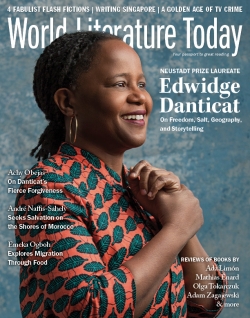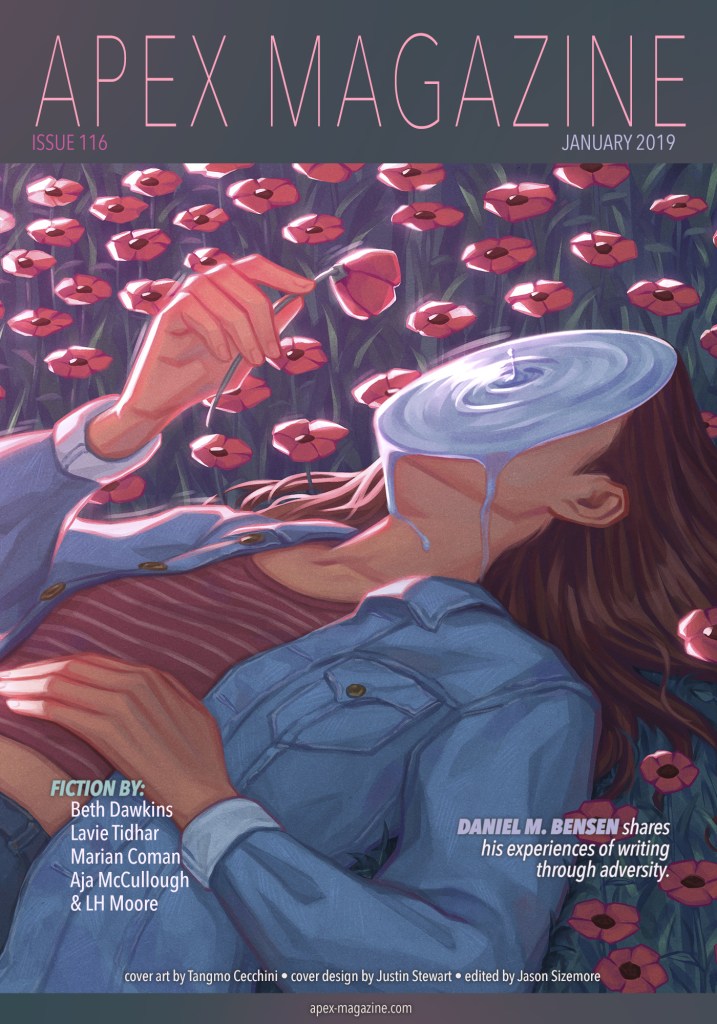Each month, Daniel Haeusser reviews short works of SFT that appear both online and in print. He is an Assistant Professor in the Biology Department at Canisius College, where he teaches microbiology and leads student research projects with bacteria and bacteriophage. He’s also an associate blogger with the American Society for Microbiology’s popular Small Things Considered. Daniel reads broadly in English and French, and his book reviews can be found at Reading1000Lives or Skiffy & Fanty. You can also connect with him on Goodreads or Twitter.
![]() “And the Wind Passes Dancing…” by Massimo Soumaré, translated from the Italian by Toshiya Kamei
“And the Wind Passes Dancing…” by Massimo Soumaré, translated from the Italian by Toshiya Kamei
Unreal Magazine January 2019
A richly descriptive brief fantasy that emphasizes mood above all else. In some post-apocalyptic setting where humanity is decimated, a lone woman wanders among the abandoned buildings of a once thriving town. She is filled with a yearning to be there, in search for some sign that humanity won’t die out, but she is uncertain of her destination. There the wind that whips through the streets senses and speaks to her. Its vague nature leaves the story open to multiple interpretations for readers, with its quiet sadness and glimmers of hope.
 “The Talus of Madame Liken” by Asja Bakić, translated from the Croatian by Jennifer Zoble
“The Talus of Madame Liken” by Asja Bakić, translated from the Croatian by Jennifer Zoble
World Literature Today Volume 93 No. 1, Winter 2019
Symbiosis is a major theme in this story, and the opening line comparing it to chaos (in the example of lichen) had me prickle, as harmony comes more to mind. But in this case the opening refers to lichen covering a naked male corpse, a victim, found outside the home of the eponymous Mme Liken, who killed him for reasons unknown. After dealing with routine questions from police, a strange young woman shows up at her door, sopping wet. This woman knows Mme Liken’s secret, and will teach her a lesson. An eerie and atmospheric piece of understatement that uses the language of conversation to create unease. After reading this I’m interested in reading more in the collection entitled Mars that this selection is taken from.
![]() “The Eternal Idol” by Amélie Olaiz, translated from the Spanish by Toshiya Kamei
“The Eternal Idol” by Amélie Olaiz, translated from the Spanish by Toshiya Kamei
Menacing Hedge Issue 8.03, Winter 2019
Taken from the name of a sculpture by Rodin, the story references multiple works by the artist as an unnamed narrator enters the Rodin Museum in Paris and experiences intimate connections to the works, ultimately incorporating with a ‘you’ addressed in the story to fuse as The Eternal Idol. Another work this month that focuses on mood, but I find it hard to relate to experiencing visual art like sculptures, and I cannot put up with the second person.
 “Sketches of a Worldwide Christo and Jeanne-Claude” by by M.H. Vesseur, translated from the Dutch by Paul Vincent
“Sketches of a Worldwide Christo and Jeanne-Claude” by by M.H. Vesseur, translated from the Dutch by Paul Vincent
Unfit Magazine January 2019
A speculative fiction of environmental land art created by the famed artists, where they drape tent cloths over a wide stretch of the Sahara to block out the sun, creating a greenhouse effect with climatic effects on the desert biome that hold potential global implications. An interesting piece that combines sci fi speculation with artistic elements to good effect.
 “The Small White” by Marian Coman, translated from the Romanian by Sebastian Simon
“The Small White” by Marian Coman, translated from the Romanian by Sebastian Simon
Apex Magazine Issue 116, January 2019
A city awakens to colorful butterflies painted on the walls of apartment buildings, drawing the wonder of a group of children, in contrast to parents who ignore the paintings, indifferent. With the images resulting from the dreams of one child, a theme of this story deals with the creativity and imagination of childhood freedom compared to the rigid severity of adulthood and responsibility. Set in the backdrop of the 1989 Romanian Revolution that marked the end of communism there, the other major theme could be what historical/political events do to the innocences of childhoods to darken the future.
 “All Saints’ Mountain” by Olga Tokarczuk, translated from the Polish by Jennifer Croft
“All Saints’ Mountain” by Olga Tokarczuk, translated from the Polish by Jennifer Croft
Hazlitt January 2019
A novella by a Nobel-nominated and Man Booker prize-winning author (and translator) that is narrated by a developmental psychologist brought to a remote Institute in the Swiss Alps to administer a developmental tendencies test to a group of teenagers. The story begins with suspense built around the simple unease of travel by plane and the unfamiliarity of setting, here where the scientist is lodged in a convent, a strange world of nuns and their religious routines. The story is complex, drawing parallels between the activities of the religious order and that of academic psychology, and the psychology of how saints or others deal with theological questions of existence – and death. But it also deals with the mystery of who these teenagers are and why the narrator has been contracted to give them the psychological test, a matter that provides the story with its speculative (science fictional) element involving the relics of saints, and their creation.
